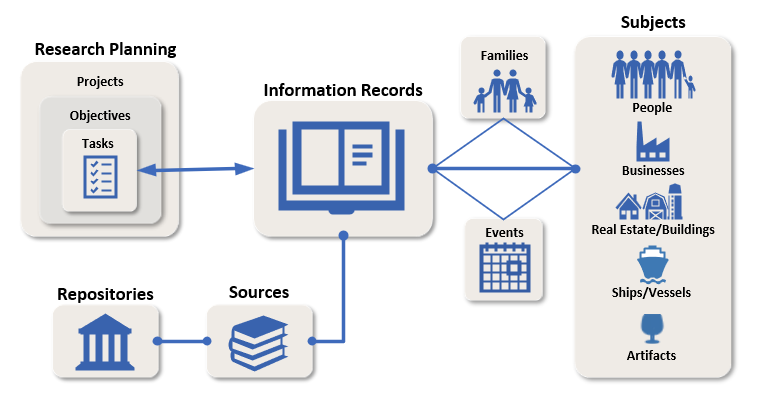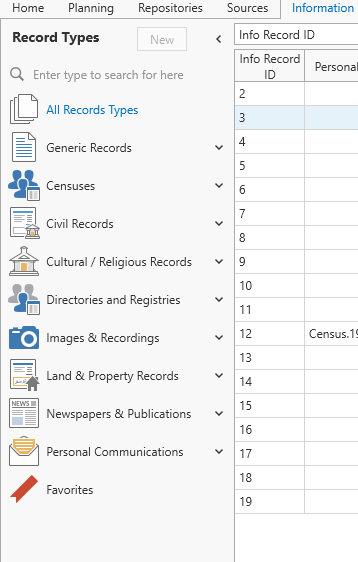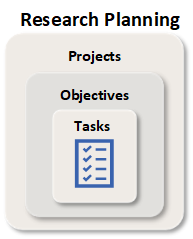Clooz data organization
The Clooz data structure consists of the following elements:
Information Records![]() Information Records in Clooz hold the content information coming from a document or other source. These differ from a Source record that contains most of the citation information describing the docment, or the Repository record referring to the facility or online service where the document was found. are the core of the Clooz data structure. There is not much you can do in Clooz that doesn't involve an Information Record. Information Records are where you enter the content data found in some information source
Information Records in Clooz hold the content information coming from a document or other source. These differ from a Source record that contains most of the citation information describing the docment, or the Repository record referring to the facility or online service where the document was found. are the core of the Clooz data structure. There is not much you can do in Clooz that doesn't involve an Information Record. Information Records are where you enter the content data found in some information source![]() A source record in Clooz should be viewed as the higher level components of a source citation. Citation details are pulled from the citing Information Record., such as a document. Subjects
A source record in Clooz should be viewed as the higher level components of a source citation. Citation details are pulled from the citing Information Record., such as a document. Subjects![]() Subjects are the objects you are gathering information about. In most cases with Clooz, this is people. However, Clooz supports several other types of subjects such as businesses, real estate/buildings, ships and artifacts. who are mentioned in the document are linked to the Information Record and any information contained in the document is entered into this Information Record. Digital media files can also be attached to Information Records. Data describing the information source itself is entered separately as a Source Record.
Subjects are the objects you are gathering information about. In most cases with Clooz, this is people. However, Clooz supports several other types of subjects such as businesses, real estate/buildings, ships and artifacts. who are mentioned in the document are linked to the Information Record and any information contained in the document is entered into this Information Record. Digital media files can also be attached to Information Records. Data describing the information source itself is entered separately as a Source Record.
- User defined identifier
- Document date
- Location (what document applied to)
- Date accessed
- User defined rating
- Description
- Subjects mentioned with information details provided, including actual name on document
- Digital media files can be attached
- Events list for any of the Subjects included given supporting data
- Family relationships between the included Subjects given supporting data
- Links to search tasks which found this Information Record
Subjects are the objects you are researching. These are usually people, however Clooz also supports other types of Subjects such as businesses, real estate![]() Real estate or buildings is a Subject type in Clooz. This could be any type of property: land plot, farm, building, etc./buildings
Real estate or buildings is a Subject type in Clooz. This could be any type of property: land plot, farm, building, etc./buildings![]() Real estate or buildings is a Subject type in Clooz. This could be any type of property: land plot, farm, building, etc., ships, and artifacts
Real estate or buildings is a Subject type in Clooz. This could be any type of property: land plot, farm, building, etc., ships, and artifacts![]() Artifacts are one of the Subject types in Clooz. They are meant to represent physical objects that have some significance in your research or family history.. You link Subjects to any Information records that contain information about them. Family structures and events involving a Subject can be created under each individual Information record (when the data supports it).
Artifacts are one of the Subject types in Clooz. They are meant to represent physical objects that have some significance in your research or family history.. You link Subjects to any Information records that contain information about them. Family structures and events involving a Subject can be created under each individual Information record (when the data supports it).
When entering Information Records, if you are unsure about the identity of a Subject (whether they are the same person as the person you are intending) it is best to create a new Subject record![]() These are records in the Clooz database representing the Subjects being researched, and contain summary information about the Subject such as the birth, marriage, and death dates for people. instead of linking to an existing one. At some later point in time when you have made a proper judgment about the two Subject records being the same person, you can merge the two Subjects into one.
These are records in the Clooz database representing the Subjects being researched, and contain summary information about the Subject such as the birth, marriage, and death dates for people. instead of linking to an existing one. At some later point in time when you have made a proper judgment about the two Subject records being the same person, you can merge the two Subjects into one.
The data in Subjects records are meant to be based on your best assessment of all the evidence contained in the Information Records they are linked to.
Subject Content:
- User definable fields (Alternate ID, User Field 1, User Field 2; Your own labels for User Field 1 and 2 can be set in the program Options.)
- Name fields (standardized form as desired by user)
- Subject type dependent fields
Keep in mind that artifacts (as Subjects) are something you are researching or tracking (provenance). For example, researching the history of a family heirloom. If an artifact (for example, a family Bible) is the source of some information you use, then it should be a Source. An artifact can be both a Source and a Subject.
Within the context of a single Information Record, you can create a family structure and define events for the linked Subjects when the information contained in the record includes family relationships or data sufficient to define an event involving the Subject. These family structures and events only reflect the data contained in this Information Record, and no other data. One of these family structures typically does not describe the whole family, just two or more people documented in this record (think of how censuses for a family evolve over the years as new children appear and older children leave the household). All of this supports the ability to view all of the family records and events related to an individual Subject across multiple Information Records, allowing correlation and consistency analysis to be done to draw conclusions and develop the complete description of a Subject.
Source records are where you enter data about the source (ex., title, author, publishing information) to identify where the data in an Information Record came from. The data in a Source record comprise a major part of formal source citations, but not all. Some details normally included in source citations come from the Information Record. Clooz is focused on collecting the data needed for complete and accurate source citations, with the final format of source citation data left to the user as part of follow-on publishing using other software since the guidelines for citation formats can vary depending on where the data are published.
- Book
- Certificate
- Journal
- Newspaper
- Register
- Document
- Image
- Website
- Personal Communication
- Title
- Label (A user controlled descriptive label to show on internal Clooz lists)
- Author or Creator
- Facility identification and call number information (filing, collection numbers, etc)
- Date accessed
- Publishing details
- User Rating (arbitrary definition controlled by user; positive stars or negative X's)
- Published URL
- Original source credit line
- Digital media files can be attached
- Links to tasks involving the source (Research Planning)
A Repository![]() Where a source document or item was found. This could be a physical library facility or online data provider. is the facility (such as a library) or online data service (the large Internet web sites serving as a virtual libraries) where sources were found.
Where a source document or item was found. This could be a physical library facility or online data provider. is the facility (such as a library) or online data service (the large Internet web sites serving as a virtual libraries) where sources were found.
Repository record content:
- Name of the Repository
- Standard address fields
- Email address and Home Page URL
- Digital media files can be attached
- Links to tasks involving the repository (link to Research Planning)
Project records are research planning efforts you define which are comprised of multiple objectives and tasks to complete them. This can be focused on a family, family line(s), lineages, pedigrees or any other overall goal of your choosing.
Project record content:
- Title
- User defined identifier
- Status with flags for completed or hidden (archived)
- Priority rating
- User defined rating
- Purpose
- Description
Research objectives![]() What you are trying to accomplish while researching some specific issue, question, or hypothesis. are descriptions of what you are trying to accomplish as part of an overall research planning project. An objective is recommended to be a question to be answered or some other goal for which you can determine has been has been answered or completed. Each objective include any number of tasks detailing the activities you need to perform to complete the objective.
What you are trying to accomplish while researching some specific issue, question, or hypothesis. are descriptions of what you are trying to accomplish as part of an overall research planning project. An objective is recommended to be a question to be answered or some other goal for which you can determine has been has been answered or completed. Each objective include any number of tasks detailing the activities you need to perform to complete the objective.
Research Objective content:
- Title
- User defined identifier
- Status with flags for completed and hidden (archived)
- Priority rating
- User defined rating
- Objective statement
- Knowledge known
- Hypothesis
- Conclusions
- Links to Subjects associated with this objective
Tasks are activities you need to perform while completing an objective. These are usually searches, analysis or administrative actions. You can define repositories or known sources to be searched. Resulting Information Records generated by the search can be linked to these tasks as search results.
Task record content:
- Title
- User defined identifier
- Type of task (search, analysis, or other)
- Start and Completion dates
- Status with flags for completed and hidden (archived)
- Priority rating
- User defined rating
- Search Parameters
- Task Description
- Results Description
- Default Source (for Information Records generated under this task)


